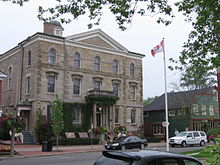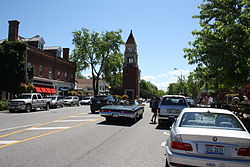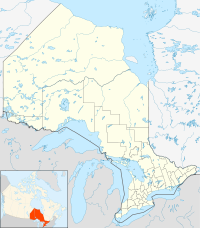- Niagara-on-the-Lake
-
Niagara-on-the-Lake — Town — Nickname(s): The Loveliest Town in Canada Location of Niagara-on-the-Lake in the Niagara Region Location in Ontario Coordinates: 43°15′19″N 79°4′18″W / 43.25528°N 79.07167°WCoordinates: 43°15′19″N 79°4′18″W / 43.25528°N 79.07167°W Country  Canada
CanadaProvince  Ontario
OntarioRegion Niagara Settled 1781 Incorporated 1792 Government - Lord Mayor Dave Eke - Governing body Town Council - MP Rob Nicholson - MPP Kim Craitor Area[1] - Land 132.83 km2 (51.3 sq mi) Elevation 82.3 m (270 ft) Population (2006) - Total 14,587 - Density 109.8/km2 (284.4/sq mi) [1] Time zone Eastern (EST) (UTC-5) - Summer (DST) Eastern Daylight (EDT) (UTC-4) Postal code L0S 1J0 Area code(s) 905/289 Website www.notl.org  The Court House, a Shaw Festival theatre and Parks Canada headquarters of Niagara National Historic Sites.
The Court House, a Shaw Festival theatre and Parks Canada headquarters of Niagara National Historic Sites.
Niagara-on-the-Lake (2006 population 14,587) is a Canadian town located in Southern Ontario where the Niagara River meets Lake Ontario in the Niagara Region of the southern part of the province of Ontario. It is located across the Niagara river from Youngstown, New York, USA. It is also the only town in Canada that has a Lord Mayor.
Contents
History
The original site was a Neutral Nation village known as Onghiara. In 1781 the British government established Butlersburg, which later became known as West Niagara. Many of the first white inhabitants were loyal to Britain, and had fled during and immediately after the American Revolution.[citation needed]
In 1792 the village was incorporated as the Town of Newark and was named the capital of the Province of Upper Canada. The town lost that distinction to York (now Toronto) in 1797, as Newark's proximity to the United States presented a danger. The town was renamed Niagara in 1798. During the War of 1812, American forces invaded Canada, and captured (and later destroyed) the town before they withdrew following their abandonment of captured Fort George. The British rebuilt the town, however, and today it has retained much of its historical charm. The present name was adopted around 1880 as a Postal Address to distinguish the town from Niagara Falls. The name was not officially adopted until 1970, when the Town of Niagara and the Township of Niagara were merged.[2]
Historic sites
Most of the former military sites, such as Fort George, Navy Hall, and Butler's Barracks, have been restored. Fort George's restoration was done as a "Make Work Project", guided by plans from the Royal Engineers, during the Great Depression of the 1930s, an early example of historic preservation. Fort George National Historic Site is a focal point in a collection of War of 1812 sites which, collectively, are managed by Parks Canada under the name Niagara National Historic Sites. That administrative name includes several national historic sites: Fort Mississauga, Mississauga Point Lighthouse (1804, the first on the Great Lakes), Navy Hall, Butler's Barracks, and Queenston Heights.
Niagara-on-the-Lake ("NOTL" or "N-O-T-L" in local shorthand) teems with historical plaques, many national and provincial, reflecting its significance in the establishment of many of the province's institutions. Among these were its first newspaper, lending library, parliament, historical museum, and governing body for the legal profession. Critical battles in the defence of Upper Canada took place here, at Queenston, including one in which heroine Laura Secord gained her fame. The town gave many black Americans their first taste of freedom, both as a stop on the Underground railroad for those travelling further into Upper Canada, and as a refuge in its own right. Its stock of Regency and Classical Revival buildings, considered the best in the country from the post-war of 1812 period, led the Historic Sites and Monuments Board of Canada to recommend that the town's historic district be designated a National Historic Site of Canada, a designation which was approved in 2003.[3][4] The historic centre had already been designated as a provincial Heritage Conservation District under the Ontario Heritage Act in 1986. And, although it did not make the final list, the Historic District was considered for nomination as a World Heritage Site.[5]
Other significant sites in NOTL:
- The town contains other National Historic Sites of Canada within its boundaries: the Battlefield of Fort George[6] and nearby Fort George,[7] Butler's Barracks,[8] Fort Drummond,[9] Fort Mississauga,[10] the site of the Mississauga Point Lighthouse,[11] the Niagara Apothecary (the oldest apothecary in Canada),[12] the Niagara District Court House,[13] Queenston Heights,[14][15] Queenston-Chippawa Hydro-electric Plant,[16][17] Willowbank[18][19] and Vrooman's Battery.[20]
- Old Court House Theatre 1847
- St. Mark's Church 1791 - oldest Anglican Church in Ontario
- McFarland House, built ca. 1800, is the oldest surviving building in Niagara-on-the-Lake. During the War of 1812 the house was used as both a hospital and Officer's Quarters, therefore it survived the Burning on Newark in December 1813. It is now open to the public for guided tours, as well as a tea patio.
Tourism
The town is home to the Shaw Festival, a series of theatrical productions featuring the works of George Bernard Shaw, his contemporaries, or plays about his era (1856–1950), running from April to November. The festival operates three theatres in the centre of town: the Festival, Royal George, and Court House theatres, and features one of a repertory acting company, scenic staff, and collection of resident and guest directors considered some of the best in the English-speaking world.
The surrounding region enjoys a comparatively mild climate thanks to the adjoining lakes, and excellent soil for fruit production, for which it has become one of Canada's centres. In particular, NOTL has grown into a major viticultural region. Visitors flock to dozens of nearby wineries, including those making the world's largest volumes of ice wine. The town is also known for its gardens, art galleries, antique shops, and golf courses. There are many hotels, inns, bed and breakfasts, and spas in the area.
The town accentuates its British heritage, and features the only Lord Mayor in Canada. Prior to 1970, the town was simply the Town of Niagara, and the title was Mayor. In 1970, the Town of Niagara, and the Township of Niagara were merged to create the Town of Niagara-on-the-Lake. The title of "Lord Mayor" was to be given to all Mayors from that time forward. Many people incorrectly refer to the Mayor of Niagara prior to 1970 as "Lord Mayor". The first Lord Mayor was Frederick S. Goring.
Location Shooting Several popular films and TV shows have been shot on location in the NOTL Old Town, including:
- When Michael Calls, also released as Shattered Silence (1972), which starred Michael Douglas, Ben Gazzara & Elizabeth Ashley
- The Dead Zone (1983), which starred Christopher Walken, Martin Sheen, Brooke Adams & Tom Skerritt
- The Experts (1989), which starred John Travolta, Arye Gross & Kelly Preston
- Trapped in Paradise (1994), which starred Nicolas Cage, Dana Carvey & Jon Lovitz
- The Ref (1994), which starred Dennis Leary, Judy Davis & Kevin Spacey
- Canadian Bacon (1995), which starred John Candy, Alan Alda & Rhea Perlman
- An All American Fairytale (2001)
- Mighty Niagara
- Samuel Lount (1985)
- That Old Feeling (1997)
- Amelia (film)|Amelia (2009), which starred Richard Gere, Hilary Swank, and Ewan McGregor
Demographics
Census Population 1871 1,600 1901 1,258 1911 1,318 1921 1,357 1931 1,228 1941 1,541 1951 2,712 1961 2,108 1971 12,552 1981 12,186 1991 12,945 2001 13,839 2006 14,587 Only 15% of the population is under 14 years of age. Those over 65 years of age number 22.6% and constitute a fast-growing population. The town has seen growth of almost 1% yearly, partially due to a large number of retirees moving to the town.
Awards and recognition
The Town of Niagara was the site of the 8th World Scout Jamboree in 1955. Over 11,000 Scouts from 71 countries attended the Jamboree. It was the first to be held outside Europe and had the theme "Jamboree of New Horizons". Niagara-on-the-Lake was named the Prettiest Town in Canada in 1996 by Communities in Bloom, a nationwide beautification programme.[21] The town is now a popular tourist destination, located at the northern terminus of the Niagara Parkway, a scenic drive and biking/walking path.
Communities
 Queenston, around 1805, by army surgeon Edward Walsh.
Queenston, around 1805, by army surgeon Edward Walsh.
In addition to the primary town site of Niagara-on-the-Lake, the town also includes the villages of Glendale, Homer, McNab, Queenston, St. Davids and Virgil.
Glendale is located near the junction of the QEW, Highway 405, and Highway 55, and adjacent to the Welland Canal. It is home to the Niagara-on-the-Lake campus of Niagara College.
Virgil is located just south-west of old town Niagara-on-the-Lake, where most of the tourism takes place. The community has a large Mennonite community, who originally settled the area in the early to mid 20th-century. Virgil has a large sports park, serving as the centre of Niagara-on-the-Lake's bustling hockey, softball, lacrosse and soccer leagues, two arenas, three baseball diamonds and a skate park. Once a year, on the Victoria Day weekend in May, the community holds its annual "Stampede". The festival includes rides and attractions. Virgil's educational institutions are St. Michael's Elementary School and Crossroads Public School, which opened in September 2011, amalgamating the now-closed Virgil and Colonel John Butler Public Schools. The town's only secondary school, Niagara District, was closed by the District School Board of Niagara in 2010. The Old Town also has an elementary school, located on King Street - Parliament Oak Public School. St. Davids Public School serves JK to Grade 8 students in the southern part of the municipality.
References
- ^ a b "Niagara-on-the-Lake community profile". 2006 Census data. Statistics Canada. http://www12.statcan.gc.ca/census-recensement/2006/dp-pd/prof/92-591/details/page.cfm?Lang=E&Geo1=CSD&Code1=3526047&Geo2=PR&Code2=35&Data=Count&SearchText=Niagara-on-the-Lake&SearchType=Begins&SearchPR=01&B1=All&Custom=. Retrieved 2011-02-04.
- ^ InfoNiagara.com
- ^ Niagara-on-the-Lake, Directory of Designations of National Historic Significance of Canada
- ^ Niagara-on-the-Lake. Canadian Register of Historic Places.
- ^ Parks Canada Tentative List for World Heritage Sites, 2004.
- ^ Battlefield of Fort George. Canadian Register of Historic Places.
- ^ Fort George. Canadian Register of Historic Places.
- ^ Butler's Barracks. Canadian Register of Historic Places.
- ^ Fort Drummond. Canadian Register of Historic Places.
- ^ Fort Mississauga. Canadian Register of Historic Places.
- ^ Mississauga Point Lighthouse. Canadian Register of Historic Places.
- ^ Niagara Apothecary. Canadian Register of Historic Places.
- ^ Niagara District Court House. Canadian Register of Historic Places.
- ^ Queenston Heights, Directory of Designations of National Historic Significance of Canada
- ^ Queenston Heights. Canadian Register of Historic Places.
- ^ Queenston-Chippawa Hydro-electric Plant, Directory of Designations of National Historic Significance of Canada
- ^ Queenston-Chippawa Hydro-electric Plant. Canadian Register of Historic Places.
- ^ Willowbank, Directory of Designations of National Historic Significance of Canada
- ^ Willowbank. Canadian Register of Historic Places.
- ^ Vrooman's Battery. Canadian Register of Historic Places.
- ^ Washington Times, 23 July 2004
External links
- Niagara-on-the-Lake official site
- Niagara-on-the-Lake Chamber of Commerce Web Site
- Niagara-on-the-Lake Bed and Breakfast Association
- Niagara-on-the-Lake Museum Web Site
- Images from the Historic Niagara Digital Collections at the Niagara Falls Public Library
- Niagara-on-the-Lake, Ontario, from The Canadian Encyclopedia

Lake Ontario 
St. Catharines 
Niagara River / Porter, Youngstown, Lewiston (NY, United States)  Niagara-on-the-Lake
Niagara-on-the-Lake 

Niagara Falls Cities Towns Townships See also: Communities in Niagara Region • Census divisions of Ontario National Historic Sites of Canada by location
National Historic Sites of Canada by locationProvinces Territories Northwest Territories · Nunavut · YukonOther countries FranceCategories:- Niagara-on-the-Lake
- Upper Canada
- Populated places established in 1781
- Populated places on the Great Lakes
Wikimedia Foundation. 2010.






